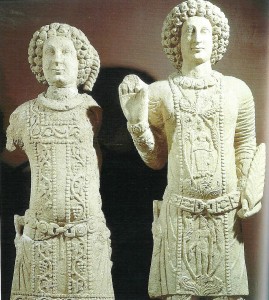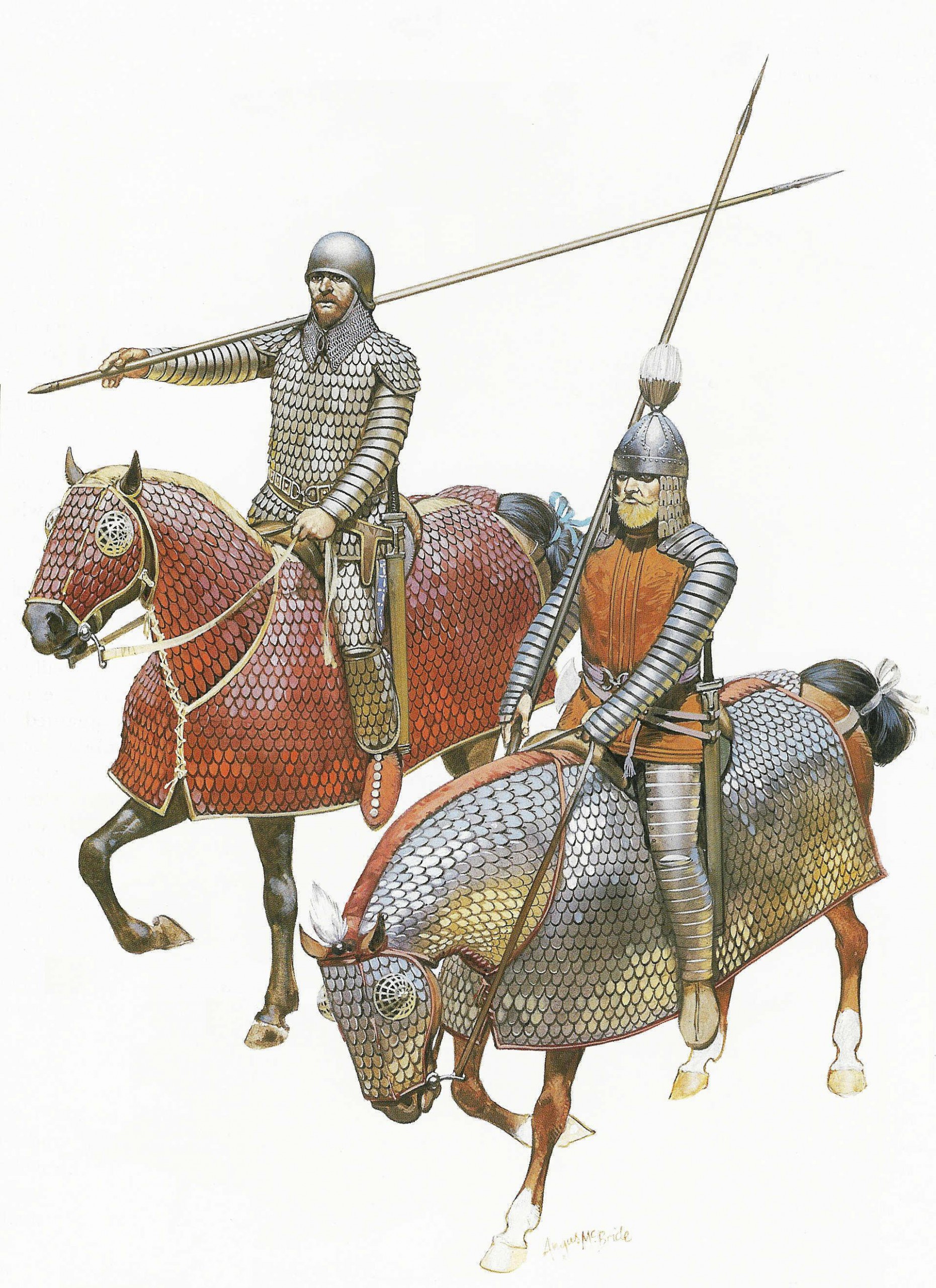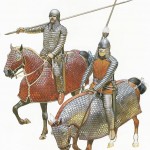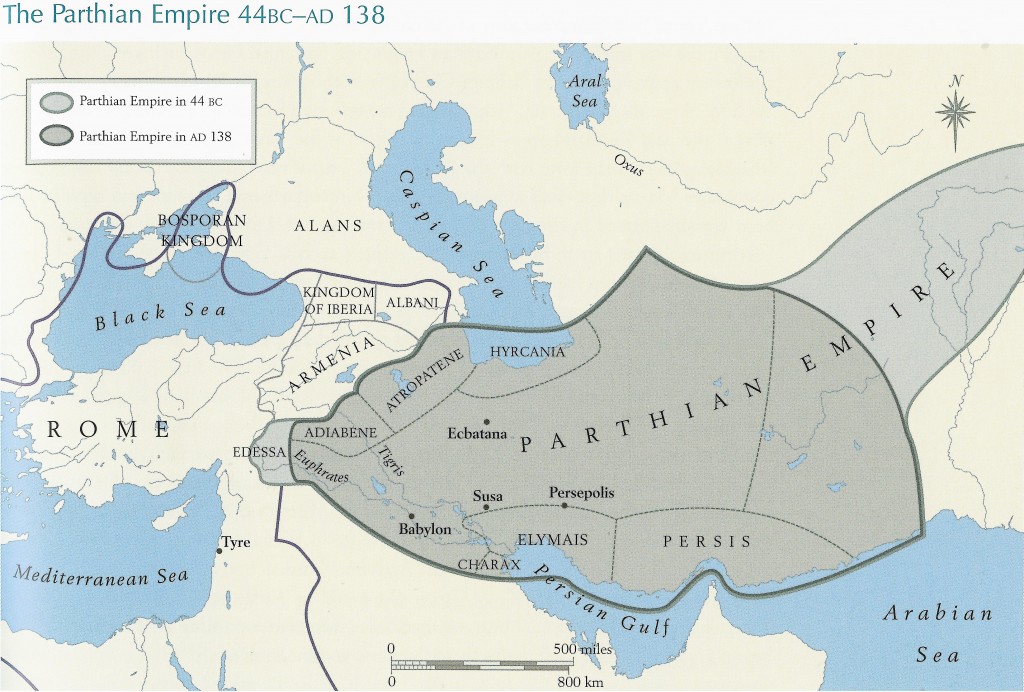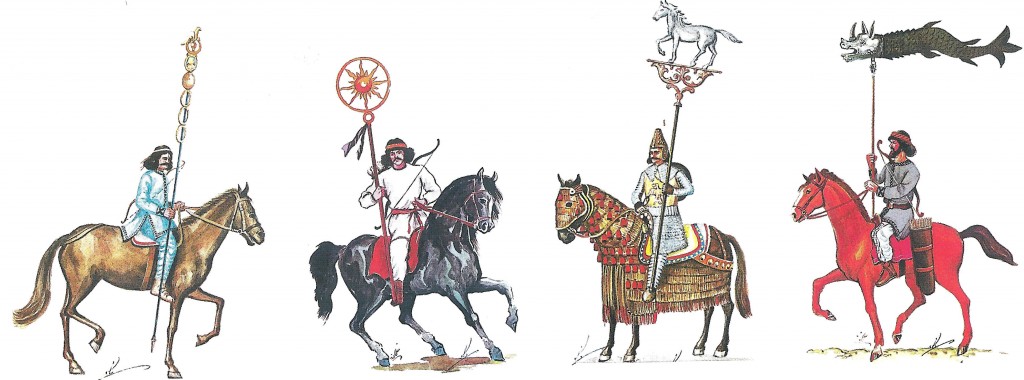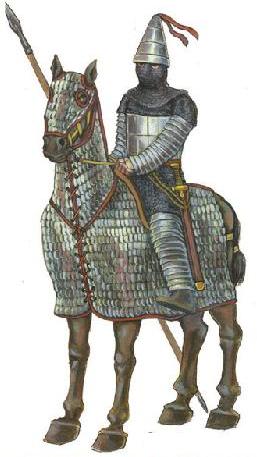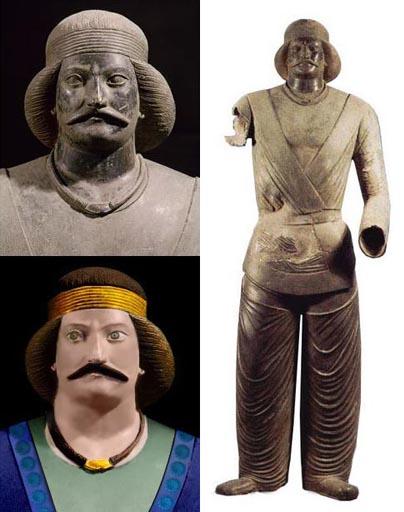The posting below highlights the late Professor Shapour Shahbazi’s discussion of the Parthian army which was orginally published in the Encyclopedia Iranica on December 15, 1986 .
For more on Parthian Military History click on the picture below:
Kindly note that a number of pictures displayed in the Shahbazi article below are from Kaveh Farrokh’s lectures at the University of British Columbia’s Continuing Studies Division , Stanford University’s WAIS 2006 Critical World Problems Conference Presentations on July 30-31, 2006; Farrokh’s textbook Shadows in the Desert: Ancient Persia at War-Персы: Армия великих царей-سایههای صحرا-) as well as venues such as the Civilization Fanatics Center and Ancientbattles.com.
==========================================================================
The Greco-Persian wars and Alexander’s victories proved that light-armed troops could not stop heavy, well-trained, and brilliantly led infantry of the type of hoplites or phalanx. These could only be encountered with heavily armed and highly professional cavalry causing disorder in the massed ranks and then attacking them on vulnerable points with bowshots capable of piercing armor and lances effective against shields. This lesson went home with the Parthians who in ousting the Seleucids from Iran had ample opportunity to experience the effect of heavily armed professional infantry led by Macedonian kings, and soon came to learn about the armament, tactics, and strategy of the Roman empire as well. So they formed their armies on sound bases, taking into consideration what was needed and what was available to them.
In extent, the Parthian empire was smaller than that of the Achaemenids; it was also far less centralized. It lacked, for instance, a standing army (Herodian 3.1). There were of course the garrisons of towns and forts as well as armed retinues of tribal chiefs, feudal lords, and of the Great King himself, but these were limited and disunited. The military concerns were conditioned by the feudal system: when the need arose, the Great King appealed to his subordinate kings (there were 18 of them at one time: Pliny, Natural History 2.26), regional, and tribal lords and garrison commanders to muster what they could and bring them to an appointed place at a given time (Herodian, loc. cit.). The feudal lords and officials brought the mustering levies (*hamspāh: E. Herzfeld, Altpersische Inschriften, Berlin, 1938, pp. 313f.), and sometimes supplemented them with foreign mercenaries (Josephus, Jewish Antiquities 18.9.2, 22.3.4; on the mercenaries in general see J. Wolski, “Le rôle et l’importance des mercenaries dans l’état parthe,” Iranica Antiqua 5, 1965, pp. 103ff.). The backbone of the army (Parth. spā’) and the chief power of controlling the empire consisted of the Parthians themselves. Accustomed from an early age to the art of horsemanship and skilled in archery, the Parthian secured a reputation that is still echoed in the Persian term pahlavān (< Pahlav < Parθava) while Parthian tactic and shooting are examplary in military histories. [Click to Enlarge] Parthian cavalry and banners (Picture source: Farrokh, page 130, Shadows in the Desert: Ancient Persia at War-Персы: Армия великих царей-سایههای صحرا– these drawings originally appeared by Zoka in the 2,500 Year Celebrations of the Persian Empire in 1971). The nature of their state and political conditions combined with lessons of history enforced an unusual military structure in Parthia: North Iranian nomads constantly threatened eastern borders while in the west first the Seleucids and then the Romans were ever ready for full-scale invasions. Any stratagem against such a double danger required rapid mobility for going from Armenia to the Jaxartes on short notice; and the solution the Parthians found was to rely on cavalry (asbārān; ʾsbʾr attested in Nisa documents; V. G. Lukonin in Camb. Hist. Iran III/2, 1983, p. 700). It is true that Parthian armies did have foot soldiers, but their numbers were small and their function insignificant (Plutarch, Crassus 19; Appian, Bella civilia 2.18). On tactical considerations, too, only the cavalry could be useful to the Parthians, for the nomads of the east could easily break through any infantry that the Parthians were able to muster, while no Parthian infantry could have matched the Roman phalanxes on the western front. The Parthian nobles (āzāt, misunderstood by Greek and Roman sources as “free-men,” Lukonin, loc. cit.) formed the army by bringing along their dependants (misunderstood by Greek and Roman sources as “slaves,” Lukonin, ibid.). The example par excellence was Sūrēn who was not yet thirty years old when he vanquished Crassus: he came escorted by a thousand heavy-armed horsemen and many more of the light-armed riders, so that an army of 10,000 horsemen was formed by his bondsmen and dependants (Plutarch, Crassus 21 ). 400 Parthian āzāts threw an army of 50,000 mounted warriors against Mark Antony (Justin 41.2). Parthian armored lancer (Picture Source: Civilization Fanatics Center). Experience had shown that light cavalry—armed with a bow and arrows and probably also a sword—was suitable for skirmishes, hit-and-run tactics, and flank attacks, but could not sustain close combat (Justin, loc. cit.; Plutarch, Crassus 24; G. Rawlinson, The Sixth Great Oriental Monarchy, London, 1873, p. 405). For the latter task, heavy cavalry (cataphracti) was formed, which wore steel helmets (Plutarch, Crassus 24), a coat of mail reaching to the knees and made of rawhide covered with scales of iron or steel that enabled it to resist strong blows (ibid., 18, 24, 25; Justin, loc. cit.; on the description of the armor worn by the cataphracti given by the third-century story writer Heliodorus of Emesa, Aethiopica 9.15, see F. Rundgren, “Über einige iranische Lehnwörter im Lateinischen und Griechischen,” Orientalia Suecana 6, 1957, pp. 31-65 esp. pp. 33ff. with references). This was akin to the lamellar armor of the Sacians of the Jaxartes who in 130 B.C. overthrew the Greco-Bactrian kingdom (A. D. H. Bivar, “Cavalry Equipment and Tactics on the Euphrates Frontier,” Dumbarton Oaks Paper 26, 1972, pp. 273f.). The charger too was covered from head to knees by armor made of scale armor said to have been of steel or bronze (Justin, loc. cit., Plutarch, Crassus 24). An actual example of this horse-armor was found at Dura Europos (M. I. Rostovtzeff, The Excavations at Dura-Europos: Preliminary Report of the Second Season, New Haven, 1931, pp. 194ff.), while a famous graffito of the Parthian cataphract from the same site clearly demonstrates his full panoply (idem, Caravan Cities, Oxford, 1932, p. 195; F. E. Brown, “Sketch of the History of Horse Armor,” in M. I. Rostovtzeff and A. R. Bellinger, eds., The Excavations at Dura-Europos: Preliminary Report of the Sixth Season of Work, New Haven, 1936, pp. 444ff.). [Click to Enlarge] Horse armor (Bargostvan) constructed of metal scales discovered at Dura Europus mounted on leather for a horse (Picture source: Stlcc.edu). For offensive weapons the cataphract had a lance and a bow. The spear was of unusual thickness and length (Plutarch, Crassus 27, Antony 45; Dio Cassius 40.22; Herodian 4.30), and was used with such skill—relying on its weight—and power that it “often had impetus enough to pierce through two men at once” (Plutarch, Crassus 27). The bow was of the powerful and large compound type which outranged Roman weapons and its arrows, shot with swiftness, strength, and precision, penetrated the armor of the legionaries (Plutarch, Crassus 18, 24; see further Rawlinson, op. cit., p. 404; N. C. Debevoise, A Political History of Parthia, Chicago, 1938, p. 86; F. E. Brown, “A Recently Discovered Compound Bow,” Seminarium Kondakovianum 9, 1937, pp. 1-10). The cataphract was probably equipped with a knife as well (Rawlinson, loc. cit.). So armed and thus skilled, he was one of the ablest and most feared soldiers of antiquity (on the cataphract see in more detail O. Gamber, “Grundriss einer Geschichte der Schutzwaffen des Altertums,” Jahrbuch der kunsthistorischen Sammlungen in Wien 52, 1966, pp. 7ff. esp. pp. 49-52; idem, “Katafrakten, Clibanarii, Normanenreiter,” ibid., 64, 1968, pp. 7ff.; B. Rubins’s summary of Drevniĭ Khorezm by S. P. Tolstov, Moscow, 1948, in Historia 4, 1955, pp. 264ff.). The Parthian army was at times additionally supported by camel-borne troops (Herodian 4.28, 30). The animal could bear the weight of the warrior and his armor better and endure harshness longer than the horse; also, the archer could discharge his arrows from an elevated position. These would have made the division very desirable had it not been greatly hampered by Roman caltrop (tribulus) which, scattered on the battlefield, injured the spongy feet of the animal (ibid.). A reconstruction of the face on the statue of a Parthian nobleman housed at Tehran’s Iran Bastan Museum (Picture Source: Parthian Empire). The Parthian tactic was that of harassing the enemy by the hit-and-run action, dividing his forces by pretending retreat and enticing pursuit but then turning unexpectedly back and showering the foe with deadly arrows, and, finally when he was reduced in number and courage, to surround him, and destroy him with volleys of missiles. The tactic was thus unfavorable to close combat operation, and inefficient in laying siege to forts and walled towns; nor could the Parthians sustain long campaigns, especially in the winter months (Rawlinson, op. cit., pp. 406ff.). Since they lacked siege-engines, the Parthians made no use of Roman machines whenever they captured them (Plutarch, Antony 38). And since the army was composed mainly of the dependants of the āzāts, it had to disband sooner or later and go back to the land and the crops. The Parthian general desired to bring to a close a campaign as soon as possible and return home. When the Great King led the army this haste was doubled by the fear of insurrection at home, the frequency of which was the greatest weakness of the Parthian empire. The battle was furious: war cries and kettledrums resounded from all sides, setting fear in enemy ranks (Plutarch, Crassus 23, 26; Justin 41.2; Herodian 4.30); mounted on the light horse the archers showered the enemy with volley after volley, and then retreated but again turned back to shoot while the charger was at full gallop—an ancient art which came to be known as “the Parthian shot” (M. L. Rostovtzeff, “The Parthian Shot,” AJA 47, 1943, p. 174ff.). Then the shock cavalry (cataphracts) moved in, still avoiding hand-to-hand combat but picking up the enemy with their missiles and piercing them with the heavy lance. Charging on large and trained war horses (see under Asb), of which some were brought as reserves (Dio Cassius 41.24), the Parthians avoided the deficiency of the Achaemenid cavalry by carrying camel-loads of arrows for use in the field as soon as their archers ran out of their own; this enabled sustained and effective long-range engagements and reduced the number of the enemy rapidly (Plutarch, Crassus 25, see further Rawlinson, op. cit., pp. 160f.; 402ff.). The organization of the Parthian army is not clear, and lacking a standing force, a strict and complicated organization was unnecessary in any case. The small company was called wašt; a large unit was drafš; and a division evidently a gund (G. Widengren, “Iran, der grosse Gegner Roms: Königsgewalt, Feudalismus, Militarwesen,” in H. Temporini and W. Haase, eds., Aufstieg und Niedergang der römischen Welt II/9.1, 1976, 220ff. esp. pp. 281f.). The strength of a drafš was 1,000 men (Lucian cited by A. Christensen, Smeden Kāväh og det Gamle Persiske Rigsbanner, Copenhagen, 1919, pp. 23f. [tr. J. M. Unvala, “The Smith Kaveh and the Ancient Persian Imperial Banner,” Journal of the Cama Oriental Institute 5, 1925, pp. 22ff. esp. p. 37 n. 2]), and that of a corps 10,000 (cf. Sūrēn’s army). It seems, therefore, that a decimal grade was observed in the organization of the army. The whole spā’ was under a supreme commander (the Great King, his son, or a spā’pat, chosen from the great noble families). The largest army the Parthians organized was that brought against Mark Antony (50,000: Justin 41.2). At Carrhae the proportion of the lancers to the light horse was about one to ten, but in the first and second centuries the number and importance of the lancers as the major actors of the battle-field increased substantially (Bivar, op. cit., pp. 274-75). The Parthians carried various banners, often ornamented with the figures of dragons (Christensen, op. cit., tr. Unvala, pp. 37f.), but the famous national emblem of Iran, the Drafš-e Kāvīān, appears to have served as the imperial banner (ibid., p. 39). The Parthians marched swiftly but very seldom at dark (Plutarch, Crassus 29; Antony 47). They used no war chariots, and confined the use of the wagon to transporting females accompanying commanders on expeditions (Rawlinson, op. cit., p. 409). Royal family members at Hatra (Picture source: Farrokh, page 150, Shadows in the Desert: Ancient Persia at War-Персы: Армия великих царей-سایههای صحرا–). The Parthian period holds an important place in military history. Several Parthian kings—including the first and the last—fell in action, and their three century-long conflicts with Rome had profound effects on Roman military organization. For they not only succeeded in repulsing repeated Roman attempts at the conquest of Iran, but they inflicted severe defeats—even in their last days—upon the Roman invaders; and to face the long-range fighting tactics of the Parthian armored cavalry and mounted archers, the Romans started to supplement their armies of heavy and drilled infantry with auxiliary forces of riders and bowmen, thereby increasingly modifying traditional Roman arms and tactics (for details see E. Gabba, “Sulle influenze reciproche degli ordinamenti militari dei Parti e dei Romani,” in La Persia e il mondo greco-romano. Rome, 1966, pp. 51ff.). Partho-Sassanian belt buckle dated to the 2nd or 3rd century CE (Picture source: Farrokh, page 143, Shadows in the Desert: Ancient Persia at War-Персы: Армия великих царей-سایههای صحرا–). The Parthians finally submitted to an Iranian dynasty which had close links with them and retained the power of their nobility, one reason for their defeat being that while they still wore the old style lamellar armor, the Sasanians went to battle with the Roman type mail shirt, i.e., armor of chain links, which was more flexible and afforded better protection (Bivar, op. cit., p. 275).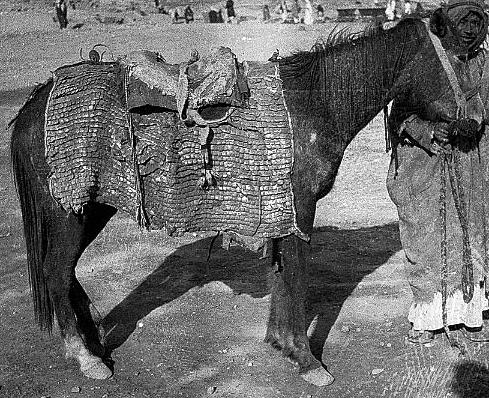
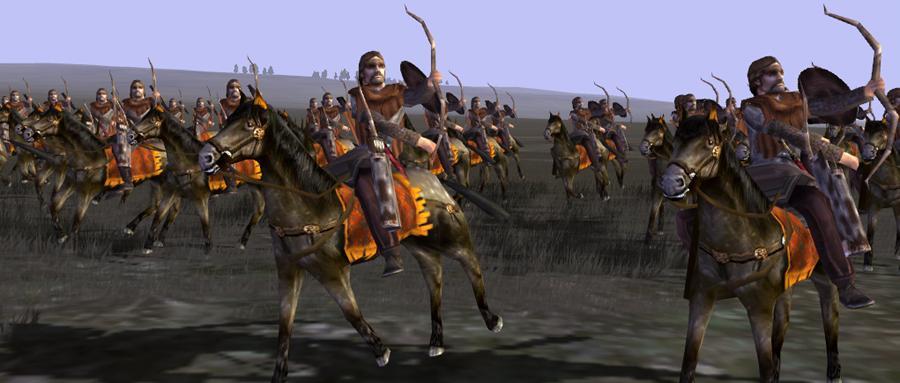 Parthian Shiva-tir (Horse Archers) engaged in discharging their missiles (Source: Ancientbattles.com).
Parthian Shiva-tir (Horse Archers) engaged in discharging their missiles (Source: Ancientbattles.com). 